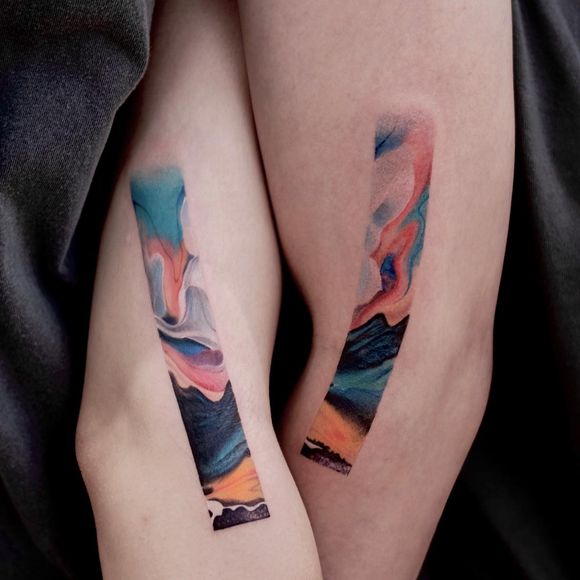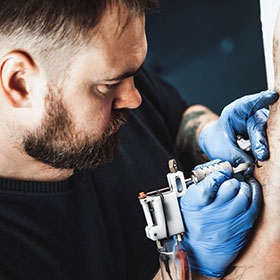Watercolor tattoos are a unique and vibrant art form. They mimic the look of watercolor paintings on the skin.
In recent years, these tattoos have gained popularity for their bright colors and beautiful designs. People are drawn to watercolor tattoos for their soft edges and fluid style. Unlike traditional tattoos with bold lines, watercolor tattoos blend colors seamlessly. This guide will help you understand everything about watercolor tattoos.
From choosing the right artist to caring for your tattoo, we cover all aspects. Whether you are new to tattoos or an experienced collector, you will find valuable tips here. Dive into the world of watercolor tattoos and discover their charm and beauty.
Introduction To Watercolor Tattoos
Watercolor tattoos are a unique form of body art. They mimic the look of a watercolor painting. Artists use a variety of techniques to achieve this effect. The result is a tattoo that looks fluid and vibrant. These tattoos often feature soft edges and blended colors.
History And Evolution
Watercolor tattoos are a relatively new style. They began gaining popularity in the late 20th century. This style draws inspiration from traditional watercolor painting.
Artists experimented with different techniques. They wanted to create tattoos that looked like watercolor art. Over time, they refined their methods. Today, watercolor tattoos are recognized for their unique beauty and creativity.
Popularity And Trends
Watercolor tattoos are now very popular. Many people choose them for their artistic appeal. Celebrities and influencers also showcase these tattoos. This has helped increase their popularity.
Current trends include:
- Abstract designs: These feature shapes and colors without clear outlines.
- Nature scenes: Flowers, trees, and animals are common subjects.
- Personalized art: People often choose designs that have personal meaning.
These trends show the versatility of watercolor tattoos. They can be customized to suit individual tastes.
Choosing The Right Artist
Selecting the right artist is crucial for a beautiful watercolor tattoo. The artist’s style, skill, and experience will significantly affect your tattoo’s outcome. This section will guide you on how to find the perfect artist for your needs.
Research And Portfolios
Start by researching different artists who specialize in watercolor tattoos. Use social media platforms like Instagram and Pinterest to find their work. Look for artists who have a strong portfolio showcasing their watercolor tattoos.
Pay attention to the following:
- Color blending and shading techniques.
- Consistency in quality and style.
- Client feedback and reviews.
Consultations And Questions
Once you’ve shortlisted a few artists, schedule consultations with them. This step is essential to ensure they understand your vision and can execute it well.
During the consultation, ask important questions such as:
- How long have they been doing watercolor tattoos?
- Can they show more examples of their work?
- What is their process for creating a custom design?
- How do they ensure colors stay vibrant over time?
By following these steps, you can find an artist who will create a stunning watercolor tattoo that you’ll love for years to come.
Design Inspiration
Watercolor tattoos are a stunning form of body art. They blend vibrant colors and unique designs. Finding the right design inspiration is crucial. It helps in creating a tattoo that is both beautiful and meaningful. Below, discover some popular design inspirations for watercolor tattoos.
Nature And Landscapes
Nature-inspired watercolor tattoos are very popular. They often include elements like flowers, trees, and animals. These designs capture the beauty of the natural world. They are perfect for those who love the outdoors.
- Flowers: Roses, lilies, and sunflowers are common choices.
- Animals: Birds, butterflies, and wolves add a wild touch.
- Landscapes: Mountains, beaches, and forests create scenic tattoos.
These designs often use soft, blended colors. This creates a dreamy, ethereal effect. Nature and landscape tattoos can be large or small. They fit well on any part of the body.
Abstract And Geometric
Abstract and geometric watercolor tattoos are modern and edgy. They often feature bold lines and vibrant colors. These designs are perfect for those who like unique and artistic tattoos.
- Shapes: Circles, triangles, and hexagons create interesting patterns.
- Lines: Bold or delicate lines add structure to the design.
- Splashes: Watercolor splashes bring a burst of color and creativity.
Abstract and geometric designs can be very versatile. They can be customized to fit any style or personality. These tattoos often look best in visible areas. They make a bold statement and show off the vibrant colors and unique patterns.
Tattoo Placement
Tattoo placement plays a crucial role in achieving the desired look and effect of your watercolor tattoo. The right placement can enhance the beauty of the design and make it stand out. Let’s explore some important factors to consider for tattoo placement.
Body Parts And Visibility
Consider which body part will best showcase your watercolor tattoo. Some popular areas include the forearm, shoulder, and back. These spots offer enough space for detailed designs. They can also be easily shown or hidden based on your preference.
The visibility of your tattoo is important. Think about your lifestyle and work environment. Choose a location that aligns with your daily activities. For example, a wrist tattoo might be more visible than one on the thigh.
Size And Proportions
The size and proportions of your watercolor tattoo should complement the chosen body part. A larger design may look better on the back or thigh. Smaller tattoos are ideal for wrists, ankles, or behind the ear.
A well-proportioned tattoo maintains its beauty over time. Make sure the design fits well with the natural curves and contours of your body. This ensures the tattoo looks balanced and aesthetically pleasing.
Color Techniques
Watercolor tattoos are known for their vibrant and fluid appearance. The secret to achieving this look lies in mastering various color techniques. These techniques bring depth, texture, and realism to the tattoo. Let’s explore some of the key color techniques used in watercolor tattoos.
Blending And Shading
Blending and shading are essential in watercolor tattoos. They create smooth transitions between colors. Artists use light, wispy strokes to blend colors seamlessly. They often use a circular motion to avoid harsh lines.
Shading adds depth to the tattoo. It mimics the natural flow of watercolors on paper. Artists achieve this by varying the pressure of their needles. They also use different dilutions of ink. This creates a gradient effect that is soft and subtle.
Layering And Textures
Layering is another crucial technique in watercolor tattoos. It involves applying multiple layers of ink. Each layer adds dimension and richness to the design. Artists wait for one layer to heal before adding the next.
Textures bring the tattoo to life. Artists use different strokes and techniques to create unique textures. They might use splatter effects to mimic paint droplets. Or they might use dry-brush techniques to create a rough, textured look.
Layering and textures together make the tattoo look dynamic. They add complexity and interest to the design. This makes each watercolor tattoo a unique piece of art.

Credit: es.pinterest.com
Pain And Aftercare
Getting a watercolor tattoo is a unique experience. The pain and aftercare are important factors to consider. Understanding these can help ensure a smooth process and beautiful results.
What To Expect
Watercolor tattoos involve needles injecting ink into the skin. This process can cause some pain. The level of pain varies from person to person. Areas with more flesh feel less painful than bony areas. The sensation is often described as a constant, sharp scratch. Each individual’s pain tolerance is different. Prepare mentally for some discomfort.
Healing Process And Tips
The healing process for watercolor tattoos is similar to other tattoos. The first few days are crucial. Keep the area clean and dry. Avoid soaking it in water. Use a mild, fragrance-free soap to clean the tattoo. Gently pat the area dry with a clean towel. Do not rub the tattoo.
Apply a thin layer of tattoo ointment. This helps keep the area moist and prevents infection. Avoid direct sunlight on the tattoo. UV rays can fade the colors. Wear loose clothing to avoid friction on the tattoo. Follow your artist’s aftercare instructions carefully. Proper care ensures a beautiful and lasting tattoo.
Common Misconceptions
Watercolor tattoos have become increasingly popular. They are known for their vibrant and artistic look. Yet, there are many common misconceptions about them. Some people think they fade quickly or are not suitable for all skin types. Let’s address these myths and set the record straight.
Longevity And Fading
One common myth is that watercolor tattoos fade faster than traditional tattoos. This is not entirely true. The longevity of a tattoo depends on several factors:
- Quality of ink used
- Skill of the tattoo artist
- Aftercare routine
If done by a skilled artist and cared for properly, watercolor tattoos can last just as long as traditional ones. Follow these simple steps to ensure your tattoo stays vibrant:
- Keep your tattoo moisturized.
- Avoid direct sunlight.
- Use sunscreen to protect it.
These steps can help prevent fading and keep your tattoo looking fresh.
Suitability For All Skin Types
Another misconception is that watercolor tattoos are only suitable for certain skin types. In reality, they can work well on all skin types. The key is to consult with an experienced tattoo artist. They can provide advice on the best techniques and colors for your skin type.
Here is a simple table to show how different skin types can affect tattoo appearance:
| Skin Type | Considerations |
|---|---|
| Light Skin | Colors appear more vibrant |
| Medium Skin | May need brighter colors |
| Dark Skin | Use bold and dark colors |
With the right approach, watercolor tattoos can be stunning on any skin type. Always discuss with your artist to get the best results.

Credit: www.tattoodo.com
Showcasing Your Tattoo
Showcasing your watercolor tattoo is an exciting part of the journey. A tattoo is a personal piece of art on your skin. You want to share it with the world in the best way possible. Below are some tips to help you display your beautiful tattoo.
Photography Tips
Capturing your tattoo in a photo needs good lighting. Natural light works best. Avoid direct sunlight as it can cause glare. Use a clean background to make your tattoo stand out. Ensure the focus is sharp. Blurry photos do not show details well. Take multiple shots from different angles. Choose the best one.
Sharing On Social Media
Sharing your tattoo on social media can reach many people. Write a brief, engaging caption. Explain the meaning or inspiration behind your tattoo. Use relevant keywords. This helps others find your post. Tag the artist who created your tattoo. Give them credit for their work. Engage with comments and questions. This builds a community around your post.
Frequently Asked Questions
What Is A Watercolor Tattoo?
A watercolor tattoo mimics the look of watercolor paintings. It features soft edges, bright colors, and a flowing style.
Do Watercolor Tattoos Fade Quickly?
Yes, watercolor tattoos can fade faster than traditional tattoos. Proper care and sun protection can help maintain their vibrancy.
Are Watercolor Tattoos More Painful?
No, watercolor tattoos are not more painful. Pain levels depend on the tattoo’s location and your personal pain tolerance.
How Long Do Watercolor Tattoos Last?
With proper care, watercolor tattoos can last many years. Touch-ups may be needed to keep colors vibrant.
Can Any Design Be A Watercolor Tattoo?
Almost any design can be adapted into a watercolor style. Consult with your tattoo artist to create the perfect piece.
Conclusion
Watercolor tattoos offer a unique, vibrant art style. They blend colors seamlessly. This guide covers everything you need to know. From choosing a design to aftercare tips, you’re now prepared. Remember, research your tattoo artist thoroughly. Ensure they specialize in watercolor techniques.
Proper care ensures your tattoo remains beautiful. Enjoy your new, colorful tattoo.

